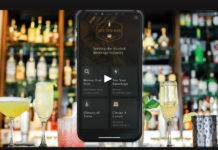For most bars in the U.S., beer and booze will always be their bread and butter. But what successful owner would consciously snub another revenue source that, when managed and executed properly, can bring them more cash? Not many. And thus, your days of dragging the occasional dust-covered bottle of cheap wine from the basement should end here. No more sour grapes.
The wine market outside of the U.S.—both retail and on-premise—has always been prominent, while the American market reamined the red-headed stepchild in the bar industry that no one wanted to tend to. Yet more and more these days, statistics about American intake and preferences show that wine is making a go of it. So how can you profit? A little bit of knowledge goes a long way.
Editor of Wine & Spirits, Megan Metcalf, told Bar Business that, with wine in particular, knowing certain stats and information can be crucial to improving your on-premise sales. “We have sources that give us information, news articles, industry statistics from Nielsen and such,” says Metcalf. “There are conferences, speeches and panels of experts. So the information is out there.”
Metcalf points out that combining knowledge of the wine segement with awareness of your own demographics can be a winning combination. “Who are your typical customers?” she says. “An older crowd will do more wine sales, and the same can be said for a heavily slanted female clientele.”
Know your crowd, and then do some research. According to Metcalf, Gallup polls show that the majority of men most often drink beer, while half of women choose wine. There is also a significant generational difference in preferences, with younger men and women favoring beer and older adults favoring wine.
Within your demographic, you should also consider economics. What are your customers earning, and what are they spending? Drinking (and spending) habits have changed, and not even the wine category can hide. Just this past July, Consumer Reports reviewed and tested several boxed wines (that’s right, wine served from a box), declaring three chardonnays “very good.” And the Duckhorn Vineyards of California’s famous Napa Valley wine region, has specifically begun producing cheaper wines, as its usual $50 to $100 price point just isn’t cutting it in today’s market. “We probably overstepped our bounds, all of us, and reached out too far in price,” owner Dan Duckhorn recently told MarketWatch.
That said, the experts do think there is a sweet spot in pricing that any good bar owner can pinpoint and base their sales on.
“I would look at the price points that people are buying in right now on the retail level, and generate a pool of select wines from that range,” suggests Metcalf. “That way, you know you are on the same page as the people walking into your bar, in terms of what they want to spend and what they want to drink.”
 “As far as quality and price range for a bar starting or improving a wine program, I think there is an ideal,” begins Philip James, President and CEO of Snooth.com, a Web site that connects wine enthusiasts and those that serve them. “The sweet spot of wines that people look at on our site ranges from $9 to $19, retail, and the peak of this range is $11 to $14. If something retails for $12, a bar would most likely pay $8 or so per bottle, and they want to sell a couple of glasses—maybe two—to break even on the bottle. I don’t think you need to sell $6 wine to make money. And I don’t think you need to sell $50 wine to make money. I think you can sell a $12 bottle of wine, for $5 or $6 dollars a glass, and make a nice profit.
“As far as quality and price range for a bar starting or improving a wine program, I think there is an ideal,” begins Philip James, President and CEO of Snooth.com, a Web site that connects wine enthusiasts and those that serve them. “The sweet spot of wines that people look at on our site ranges from $9 to $19, retail, and the peak of this range is $11 to $14. If something retails for $12, a bar would most likely pay $8 or so per bottle, and they want to sell a couple of glasses—maybe two—to break even on the bottle. I don’t think you need to sell $6 wine to make money. And I don’t think you need to sell $50 wine to make money. I think you can sell a $12 bottle of wine, for $5 or $6 dollars a glass, and make a nice profit.
“But it’s important to choose stuff that people are going to like, and that’s where a service like Snooth.com can be useful. If you don’t know where to start, you can go to our site and find good wines that are relatively widely available and have mostly familiar names and are in that sweet spot price range for a bar owner.”
Snooth.com is a tool that savvy bar owners can utilize to not only cull information about wine in general, but about wine lovers in their locale, what they’re drinking, and what they would like to have available.
“I think there are a few ways a bar owner can benefit from getting involved with Snooth.com,” says James. “It could be purely passive, and just be used as a resource. They can get a sense of what products are hot or they can learn about a specific wine or region or genre or price range, just so they can better serve their customers.
Beyond Snooth.com, James suggests several steps bar owners should take to improve their on-premise wine sales. Of course, preservation and cutting out waste is imperative. The toughest part of running a profitable by-the-glass program is not pouring half a bottle down the drain after one or two pours. Tools like Wine Saver PRO provide a cost-effective, multi-bottle system that allows bartenders to both serve as well as preserve by using innovative Argon gas cartridges. The increased shelf life of a nice bottle of wine adds value the minute you can stretch its usability.
“Bar owners also need somebody generally available who can answer customer questions about wine,” he says. “I don’t think every bar needs a sommelier, I just think everybody who is going to sell or recommend wine should have a basic level of knowledge. Even if it’s on-the-job, unofficial training, everybody needs to know what products they carry. If a customer says, ‘I’m going to have the chicken. What goes with that?’ you need to be able to answer that question.”
“Let’s say you only carry American wines,” says James. “Every time a customer comes in and says, ‘Do you have a Chablis?’ the server may say no, but there should be a way to capture that demand and say ‘Hey, 20 people a week come in asking for Chablis. What are we going to do about that?’ Either you stock a wine that is going to match, or you just ignore those potential sales. You don’t need a sommelier, you just need people working in your bar who care about the feedback from the customer, and a forum for them to pass that feedback to management or owners, and then a way to internalize that.”
To read the full article “How To: Incease On-Premise Wine Sales” check out the July/August 2009 issue of Bar Business Magazine








